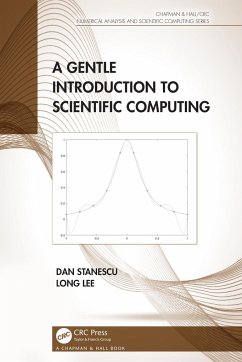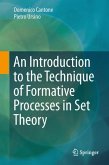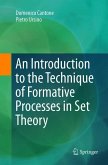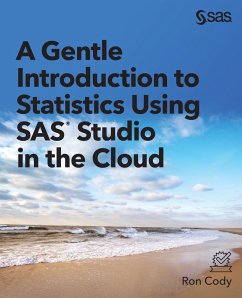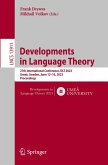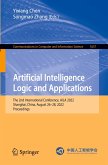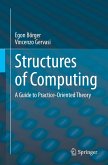- Gebundenes Buch
- Merkliste
- Auf die Merkliste
- Bewerten Bewerten
- Teilen
- Produkt teilen
- Produkterinnerung
- Produkterinnerung
This book intends to serve a very broad audience of college students across a variety of disciplines. It exposes its readers to some of the basic tools and techniques used in computational science, with a view to helping them understand what happens 'behind the scenes' when simple tools are used.
Andere Kunden interessierten sich auch für
![An Introduction to the Technique of Formative Processes in Set Theory An Introduction to the Technique of Formative Processes in Set Theory]() Domenico CantoneAn Introduction to the Technique of Formative Processes in Set Theory37,99 €
Domenico CantoneAn Introduction to the Technique of Formative Processes in Set Theory37,99 €![An Introduction to the Technique of Formative Processes in Set Theory An Introduction to the Technique of Formative Processes in Set Theory]() Domenico CantoneAn Introduction to the Technique of Formative Processes in Set Theory37,99 €
Domenico CantoneAn Introduction to the Technique of Formative Processes in Set Theory37,99 €![A Gentle Introduction to Statistics Using SAS Studio in the Cloud A Gentle Introduction to Statistics Using SAS Studio in the Cloud]() Ron CodyA Gentle Introduction to Statistics Using SAS Studio in the Cloud56,99 €
Ron CodyA Gentle Introduction to Statistics Using SAS Studio in the Cloud56,99 €![A Gentle Introduction to Statistics Using SAS Studio in the Cloud A Gentle Introduction to Statistics Using SAS Studio in the Cloud]() Ron CodyA Gentle Introduction to Statistics Using SAS Studio in the Cloud44,99 €
Ron CodyA Gentle Introduction to Statistics Using SAS Studio in the Cloud44,99 €![Developments in Language Theory Developments in Language Theory]() Developments in Language Theory48,99 €
Developments in Language Theory48,99 €![Artificial Intelligence Logic and Applications Artificial Intelligence Logic and Applications]() Artificial Intelligence Logic and Applications55,99 €
Artificial Intelligence Logic and Applications55,99 €![Structures of Computing Structures of Computing]() Egon BörgerStructures of Computing38,99 €
Egon BörgerStructures of Computing38,99 €-
-
-
This book intends to serve a very broad audience of college students across a variety of disciplines. It exposes its readers to some of the basic tools and techniques used in computational science, with a view to helping them understand what happens 'behind the scenes' when simple tools are used.
Produktdetails
- Produktdetails
- Chapman & Hall/CRC Numerical Analysis and Scientific Computing Series
- Verlag: Chapman and Hall/CRC / Taylor & Francis
- Seitenzahl: 282
- Erscheinungstermin: 2. Mai 2022
- Englisch
- Abmessung: 241mm x 159mm x 23mm
- Gewicht: 280g
- ISBN-13: 9780367206840
- ISBN-10: 0367206846
- Artikelnr.: 63084212
- Chapman & Hall/CRC Numerical Analysis and Scientific Computing Series
- Verlag: Chapman and Hall/CRC / Taylor & Francis
- Seitenzahl: 282
- Erscheinungstermin: 2. Mai 2022
- Englisch
- Abmessung: 241mm x 159mm x 23mm
- Gewicht: 280g
- ISBN-13: 9780367206840
- ISBN-10: 0367206846
- Artikelnr.: 63084212
Dan Stanescu received his undergraduate degree in Aerospace Engineering from the Polytechnical Institute in Bucharest, Romania. He then pursued his graduate studies at McGill University and obtained his Ph.D. at Concordia University, both in Montreal, Canada. His initial fascination with modeling fluid flow led him to develop both frequency- and time-domain computational methods for the study of aircraft noise. His publications include work in aeroacoustics, spectral methods, stochastic processes and biomathematics. Upon joining the Mathematics Department at the University of Wyoming in 2003, he directed the Institute for Scientific Computing for six years and initiated an Interdisciplinary Computational Science Minor program, currently offered to interested students at both the undergraduate and graduate level. He has taught a wide range of courses in applied mathematics and has been developing and using the material included herein, during the last ten years, for a core class that is part of this Minor. Long Lee is a Professor of Mathematics at the University of Wyoming in Laramie, USA. He received his Ph. D. in Applied Mathematics from the University of Washington in Seattle, USA. Before his Ph.D., he received a BS in Engineering and an MS in Geophysics. His research interests are in the area of high-performance scientific computing and its applications. He has published papers in computational fluid dynamics, nonlinear waves, and image sciences. He expanded his research to infectious diseases and network modeling in recent years due to the COVID-19 pandemic. His teaching interests are in the general area of scientific computing. In particular, he enjoys teaching numerical methods for engineering students. He has taught numerical methods, differential equations, and mathematical modeling, both undergraduate and graduate levels, at the University of Wyoming for more than fifteen years.
1. Introduction. 1.1. Scientific Computing. 1.2. MATLAB: what and why? 1.3. A Word of Caution. 1.4. Additional Resources. 2. Vectors and Matrices. 2.1. Unidimensional Arrays: Vectors. 2.2. Bidimensional Arrays: Matrices. 2.3. Matrix Operations. 2.4. Systems of Linear Equations. 2.5. Eigenvalues and Eigenvectors. 2.6. Operation Counts. 2.7. Exercises. 3. Basics of MATLAB. 3.1. Defining and Using Scalar Variables. 3.2. Saving and Reloading the Workspace. 3.3. Defining and Using Arrays. 3.4. Operations on Vectors and Matrices. 3.5. More on Plotting Functions of One Variable. 3.6. Loops and Logical Operators. 3.7. Working with indices and arrays. 3.8. Organizing Your Outputs. 3.9. Number representation. 3.10. Machine epsilon. 3.11. Exercises. 4. Solving Nonlinear Equations. 4.1. The Bisection Method for Root-Finding. 4.2. Convergence Criteria and Efficiency. 4.3. Scripts and Function Files. 4.4. The False Position Method. 4.5. The Newton-Raphson Method for Root-Finding. 4.6 Fixed Point Iteration. 4.7. MATLAB built-in functions. 4.8. Exercises. 5. Systems of Equations. 5.1. Linear Systems. 5.2. Newton's Method for Nonlinear Systems. 5.3. MATLAB built-in functions. 5.4. Exercises. 6. Approximation of Functions. 6.1. A hypothetical example. 6.2. Global Polynomial Interpolation. 6.3. Spline Interpolation. 6.4. Approximation with Trigonometric Functions. 6.5. MATLAB built-in functions. 6.6. Exercises. 7. Numerical Differentiation. 7.1. Basic Derivative Formulae. 7.2. Derivative Formulae Using Taylor Series. 7.3. Derivative Formulae Using Interpolants. 7.4. Errors in Numerical Differentiation. 7.5. Richardson Extrapolation. 7.6. MATLAB built-in functions. 7.7. Exercises. 8. Numerical Optimization. 8.1. The need for optimization methods. 8.2. Line Search Methods. 8.3. Successive Parabolic Interpolation. 8.4. Optimization Using Derivatives. 8.5. Linear programming. 8.6. Constrained nonlinear optimization. 8.7. MATLAB built-in functions. 8.8. Exercises. 9. Numerical Quadrature. 9.1. Basic Quadrature Formulae. 9.2. Gauss Quadrature. 9.3. Extrapolation Methods: Romberg Quadrature. 9.4. Higher-Dimensional Integrals. 9.5. Monte Carlo Integration. 9.6. MATLAB built-in functions. 9.7. Exercises. 10. Numerical Solution of Differential Equations. 10.1. First-order Models. 10.2. Second-order Models. 10.3. Basic Numerical Methods. 10.4. Global error and the order of accuracy. 10.5. Consistency, Stability and Convergence. 10.6. Explicit vs. Implicit Methods. 10.7. Multistep Methods. 10.8. Higher-Order Initial Value Problems. 10.9. Boundary Value Problems. 10.10. MATLAB built-in functions. 10.11. Exercises. Appendix A. Calculus Refresher. A.1. Taylor Series. A.2. Riemann Integrals. A.3. Other Important Results. Appendix B. Introduction to Octave. B.1. The Problem of Choice. B.2. Octave Basics. B.3. Octave Code Examples. Appendix C. Introduction to Python. C.1. The problem of choice. C.2. Python Basics. C.3. Installing Python. C.4. Python Code Examples. Appendix D. Introduction to Julia. D.1. The problem of choice. D.2. Julia Basics. D.3. Julia Code Examples. Appendix E. Hints and Answers for Selected Exercises. Bibliography. Index.
1. Introduction. 1.1. Scientific Computing. 1.2. MATLAB: what and why? 1.3. A Word of Caution. 1.4. Additional Resources. 2. Vectors and Matrices. 2.1. Unidimensional Arrays: Vectors. 2.2. Bidimensional Arrays: Matrices. 2.3. Matrix Operations. 2.4. Systems of Linear Equations. 2.5. Eigenvalues and Eigenvectors. 2.6. Operation Counts. 2.7. Exercises. 3. Basics of MATLAB. 3.1. Defining and Using Scalar Variables. 3.2. Saving and Reloading the Workspace. 3.3. Defining and Using Arrays. 3.4. Operations on Vectors and Matrices. 3.5. More on Plotting Functions of One Variable. 3.6. Loops and Logical Operators. 3.7. Working with indices and arrays. 3.8. Organizing Your Outputs. 3.9. Number representation. 3.10. Machine epsilon. 3.11. Exercises. 4. Solving Nonlinear Equations. 4.1. The Bisection Method for Root-Finding. 4.2. Convergence Criteria and Efficiency. 4.3. Scripts and Function Files. 4.4. The False Position Method. 4.5. The Newton-Raphson Method for Root-Finding. 4.6 Fixed Point Iteration. 4.7. MATLAB built-in functions. 4.8. Exercises. 5. Systems of Equations. 5.1. Linear Systems. 5.2. Newton's Method for Nonlinear Systems. 5.3. MATLAB built-in functions. 5.4. Exercises. 6. Approximation of Functions. 6.1. A hypothetical example. 6.2. Global Polynomial Interpolation. 6.3. Spline Interpolation. 6.4. Approximation with Trigonometric Functions. 6.5. MATLAB built-in functions. 6.6. Exercises. 7. Numerical Differentiation. 7.1. Basic Derivative Formulae. 7.2. Derivative Formulae Using Taylor Series. 7.3. Derivative Formulae Using Interpolants. 7.4. Errors in Numerical Differentiation. 7.5. Richardson Extrapolation. 7.6. MATLAB built-in functions. 7.7. Exercises. 8. Numerical Optimization. 8.1. The need for optimization methods. 8.2. Line Search Methods. 8.3. Successive Parabolic Interpolation. 8.4. Optimization Using Derivatives. 8.5. Linear programming. 8.6. Constrained nonlinear optimization. 8.7. MATLAB built-in functions. 8.8. Exercises. 9. Numerical Quadrature. 9.1. Basic Quadrature Formulae. 9.2. Gauss Quadrature. 9.3. Extrapolation Methods: Romberg Quadrature. 9.4. Higher-Dimensional Integrals. 9.5. Monte Carlo Integration. 9.6. MATLAB built-in functions. 9.7. Exercises. 10. Numerical Solution of Differential Equations. 10.1. First-order Models. 10.2. Second-order Models. 10.3. Basic Numerical Methods. 10.4. Global error and the order of accuracy. 10.5. Consistency, Stability and Convergence. 10.6. Explicit vs. Implicit Methods. 10.7. Multistep Methods. 10.8. Higher-Order Initial Value Problems. 10.9. Boundary Value Problems. 10.10. MATLAB built-in functions. 10.11. Exercises. Appendix A. Calculus Refresher. A.1. Taylor Series. A.2. Riemann Integrals. A.3. Other Important Results. Appendix B. Introduction to Octave. B.1. The Problem of Choice. B.2. Octave Basics. B.3. Octave Code Examples. Appendix C. Introduction to Python. C.1. The problem of choice. C.2. Python Basics. C.3. Installing Python. C.4. Python Code Examples. Appendix D. Introduction to Julia. D.1. The problem of choice. D.2. Julia Basics. D.3. Julia Code Examples. Appendix E. Hints and Answers for Selected Exercises. Bibliography. Index.

